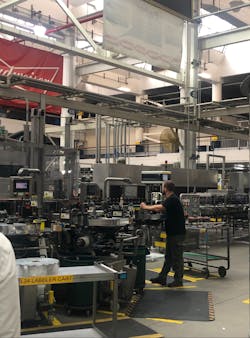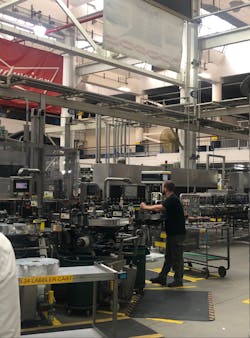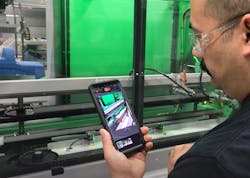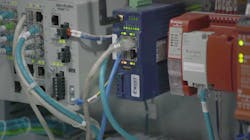The Anheuser-Busch facility in St. Louis serves as the hub of innovation for more than 30 brands—the most popular being Budweiser and Michelob Ultra. At a facility like this, multiple lines run at high speed on the packaging floor. As an example, one can line can package 1,950 12-ounce cans per minute and 1,650 16-ounce cans per minute.
With so much activity, operators have to be familiar with equipment and procedures. Unfortunately, the beverage manufacturer is not only dealing with the skills shortage impacting the entire industry, but it is also preparing to lose about 40% of its workforce that is ready to retire. That means novice operators will be running machines and learning to interpret HMIs (human-machine interaces) that have, in many instances, been in place for decades.
“Essentially, we're asking for simplicity,” he says. “We would like for all of the complexity to be under the hood [of the machine], and we would like an operator interface that's very simple, easy to understand, and enables our younger employees to interface with some type of video screen. We also look for set-up procedures that are built into the operator screen. And we’d love it if [OEMs] could help train our operators.”
Lisa Rathburn, vice president of engineering at food manufacture T. Marzetti agrees that training and easy interfaces can help close the skills gap. “We walk through the interfaces during design reviews to ensure that terminology matches what is used by our teams on the plant floor,” she says. “We are focused on standardizing where possible to simplify the diversity of knowledge needed. And we are also favoring changeover parts, rail adjustment, etc., that have clear indicators or push-button operations to reduce human error and manual adjustments.”
OEMs are listening to customers’ requests and delivering intuitive HMIs and visual learning components, as well as offering augmented reality (AR) and remote management and diagnostic technologies to offload most of the maintenance issues.
The goal is to avoid a big problem when there’s an easy fix.
“We can solve 90% of the issues remotely and within an hour,” says Robert Mize a technical support representative at Pearson Packaging Systems, a provider of end-of-line automated packaging systems.
Pearson’s remote service offering is free and available 24/7. They use several technologies to connect with customers and help them get back up and running quickly. One method employed uses PTC’s Vuforia AR technology, which allows the technician to make annotations on a shared screen. It’s a simple process that starts by sending a code to a phone with the Vuforia app and pulling up the software to allow operators and technicians to share the same screen. It does not require a remote connection to the machine and is especially useful when operators have language barriers or don’t know maintenance terminology. “It’s one of the first things we mobilize. We can see the machine and we can annotate in real time,” says Mize.
Another connection method uses an Ewon router that connects to the PLC via a secure VPN tunnel. The router enables the technical support team to see the state of the machine, including PLC and sensor data, as well as make corrections to the code if necessary. “Back in 2019, we made the decision that we were going to equip any plant or industrial network [our machines] are in with the ability to remote connect,” says Brian Patrick, Pearson’s vice president of engineering. “It’s allowed us to make further investments, not only just putting remote connection on machines, but also being able to send things out quickly from a support standpoint.”
In certain cases, Pearson also provides cameras that can be set up around the machine so that when a remote session takes place, technical support can see what the customer is seeing. This is especially helpful when a situation has to be assessed over a period of time.
Urgent calls
These types of services are proving to be vital
given the current state of the workforce. For
example, during a routine customer service
call to Pearson tech support, Mize answered
questions about a machine while trying to
gauge the operator’s familiarity with the technology.
That’s when he learned that the caller
had actually been a cashier at the warehouse
retail site just an hour before being reassigned
to the machine operator role.
“Even the tone of the callers is totally different than it was a few years ago,” Mize says. “There’s a sense of urgency. It’s like they’ve been dropped off in the middle of the ocean and have to learn to swim for themselves.”
The urgency is heightened because every second counts. “Our customers make money when they get boxes out the door,” says Paul Wolf, director of customer service at R.A.Jones, a supplier of primary and secondary packaging machinery. “So how do you get a new hire to operate a line in a day?” One solution, Wolf says, is a two-minute training video.
The company has identified several of the most common faults on its machines and are now scripting out short, documentary-like videos on how to fix them. “A lot of documentation gets lost, but with a video of how to fix it, we can get an operator up to speed in record time,” Wolf says, noting they are also embedding videos in HMIs and online manuals, which can be customized to customer needs.
Other OEMs are aiding the untrained operator by developing somewhat self-sufficient machines.
At PACK EXPO International in October, BellatRx introduced a new labeling machine that includes a piece of equipment that takes the measurements of a bottle, which when entered into the HMI, automatically creates a recipe in which all of the conveyors, label dispensing, wrap, and metering wheel speeds are automatically set and synchronized without further operator intervention. This gets the operator to 90% of where the set up needs to be just by measuring the bottle. “They don’t need to understand dispense speed or any of that because we understand it, and we write in the code and algorithms to calculate the speeds,” explains BellatRx president and CEO Alan Shuhaibar. “All you need to do is measure the bottle and enter the dimensions.”
A short animation or video also serves as a step-by-step guide in the HMI on how to get the BellatRx labeler up and running. The video is coupled with an LED light strip installed along the length of the machine. When setup is required on a certain assembly, the section of the LED strip in front of that assembly will light up to draw the operator’s attention to that point. The mechanical adjustments include electronic feedback which turns the LED light green when it is in the correct setpoint or red when it is not. On the HMI, the operator cannot progress to the next screen unless all setpoints for that assembly are green.
In the past, the OEM’s expectation was that the operator knew how to set up the machines. But that’s no longer true in many cases. In addition, people expect the same user-friendly interface as an iPhone. “We are trying to take that mindset and put it into the machines. You shouldn’t need a PhD to run a labeler,” Shuhaibar says.
The company has also reinvented its automation approach over the last two years with its softwaredriven ctrlX Automation platform. By going back to the drawing board in its development of this platform, the company erased the traditional boundaries between machine control systems, IT, and Internet of Things (IoT) to create a flexible and scalable platform based on the Linux real-time operating system, open standards, and comprehensive IoT connectivity with web-based engineering.
Using the Blockly visual programming language the platform provides a drag-and-drop function block that builds sequentially. “So now, instead of memorizing dozens of lines of code, you just have to understand that this block means a kinematic move sequence. This makes it easy to use and to train someone to use,” explains Brad Klippstein, product manager for smart mechatronics at Bosch Rexroth. “In under five minutes we can teach you how to use this interface and program your process.”
In addition, Bosch is helping OEMs and customers alike by providing them with its LinSelect online tool for designing and commissioning of machines. “It allows you to input the parameters of whatever you are trying to do.” If you are trying to move boxes from point A to point B, for example, just input the distance needs, weight of the box, and a few other details pertinent to the process. “Our system sizes and selects the mechanical, electrical, and software components that fit together based on your application.”
Desperate times call for desperate measures. Given the current circumstances, it’s becoming acceptable to relinquish control to the experts. “We always have a plan B with the remote connection of a machine,” says Pearson’s Patrick. “We have the ability to take over the machine, so if an operator is not comfortable doing something, they can grant us access to use the HMI remotely.”
To be clear, this scenario requires specific conditions with the machine in a certain state for it to work, Patrick notes, emphasizing “there is no opportunity to put someone in danger.”
Taking even this small step in allowing restricted remote control of machines is a big deal for many end users, but it’s something they could ultimately be asking for in greater numbers.
“It's always a challenge with our IT team to [allow for] remote [access] into anything in the brewery,” says Anheuser-Busch’s VonderHaar. “And that's just because of the risk. But I think the trend is there, and we have to figure out how to do that. And at the end of the day, yes, we want to do that. We need to figure out how to do that safely and try to do it in a manner that doesn't put our operations at risk.”




